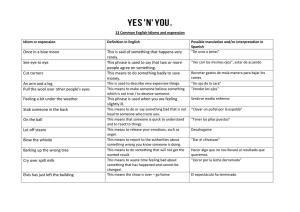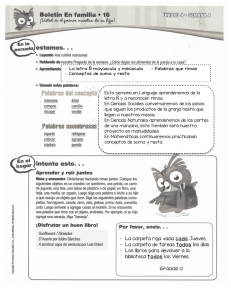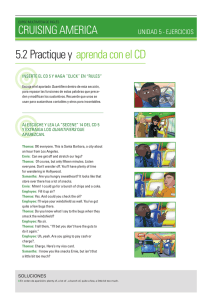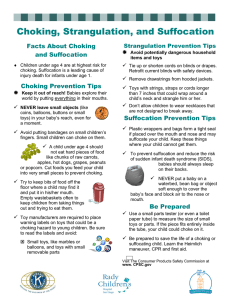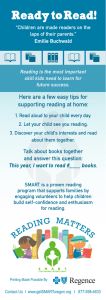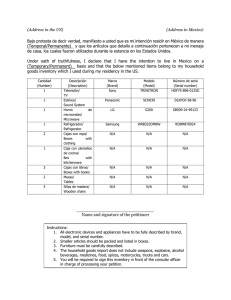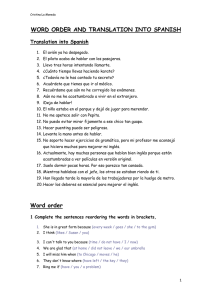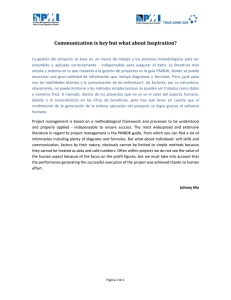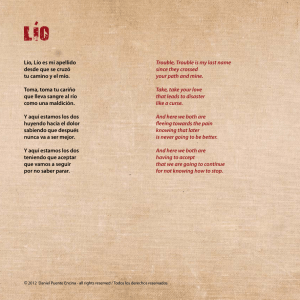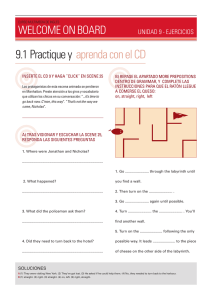Seguridad con los juguetes - Children`s Hospital Los Angeles
Anuncio
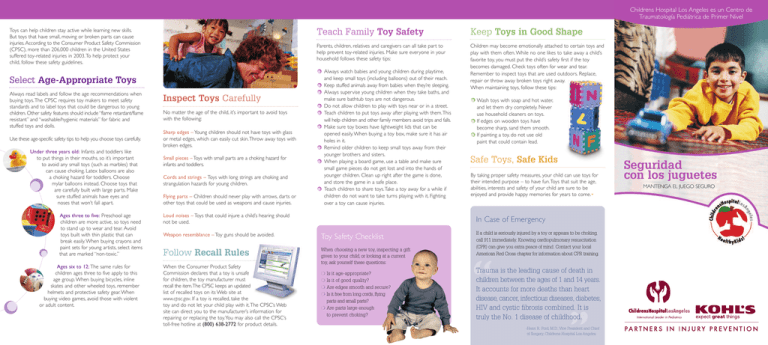
Childrens Hospital Los Angeles es un Centro de Traumatología Pediátrica de Primer Nivel Select Age-Appropriate Toys Always read labels and follow the age recommendations when buying toys.The CPSC requires toy makers to meet safety standards and to label toys that could be dangerous to young children. Other safety features should include “flame retardant/flame resistant” and “washable/hygienic materials” for fabric and stuffed toys and dolls. Use these age-specific safety tips to help you choose toys carefully. Under three years old: Infants and toddlers like to put things in their mouths, so it’s important to avoid any small toys (such as marbles) that can cause choking. Latex balloons are also a choking hazard for toddlers. Choose mylar balloons instead. Choose toys that are carefully built with large parts. Make sure stuffed animals have eyes and noses that won’t fall apart. Ages three to five: Preschool age children are more active, so toys need to stand up to wear and tear. Avoid toys built with thin plastic that can break easily. When buying crayons and paint sets for young artists, select items that are marked “non-toxic.” Ages six to 12: The same rules for children ages three to five apply to this age group. When buying bicycles, inline skates and other wheeled toys, remember helmets and protective safety gear. When buying video games, avoid those with violent or adult content. Inspect Toys Carefully No matter the age of the child, it’s important to avoid toys with the following: Sharp edges – Young children should not have toys with glass or metal edges, which can easily cut skin.Throw away toys with broken edges. Small pieces – Toys with small parts are a choking hazard for infants and toddlers. Cords and strings – Toys with long strings are choking and strangulation hazards for young children. Flying parts – Children should never play with arrows, darts or other toys that could be used as weapons and cause injuries. Teach Family Toy Safety Keep Toys in Good Shape Parents, children, relatives and caregivers can all take part to help prevent toy-related injuries. Make sure everyone in your household follows these safety tips: Children may become emotionally attached to certain toys and play with them often. While no one likes to take away a child’s favorite toy, you must put the child’s safety first if the toy becomes damaged. Check toys often for wear and tear. Remember to inspect toys that are used outdoors. Replace, repair or throw away broken toys right away. When maintaining toys, follow these tips: Always watch babies and young children during playtime, and keep small toys (including balloons) out of their reach. Keep stuffed animals away from babies when they’re sleeping. Always supervise young children when they take baths, and make sure bathtub toys are not dangerous. Do not allow children to play with toys near or in a street. Teach children to put toys away after playing with them.This will help children and other family members avoid trips and falls. Make sure toy boxes have lightweight lids that can be opened easily. When buying a toy box, make sure it has air holes in it. Remind older children to keep small toys away from their younger brothers and sisters. When playing a board game, use a table and make sure small game pieces do not get lost and into the hands of younger children. Clean up right after the game is done, and store the game in a safe place. Teach children to share toys.Take a toy away for a while if children do not want to take turns playing with it. Fighting over a toy can cause injuries. Loud noises – Toys that could injure a child’s hearing should not be used. Safe Toys, Safe Kids By taking proper safety measures, your child can use toys for their intended purpose – to have fun.Toys that suit the age, abilities, interests and safety of your child are sure to be enjoyed and provide happy memories for years to come.• In Case of Emergency Weapon resemblance – Toy guns should be avoided. Toy Safety Checklist Follow Recall Rules When choosing a new toy, inspecting a gift given to your child, or looking at a current toy, ask yourself these questions: When the Consumer Product Safety Commission declares that a toy is unsafe for children, the toy manufacturer must recall the item.The CPSC keeps an updated list of recalled toys on its Web site at www.cpsc.gov. If a toy is recalled, take the toy and do not let your child play with it.The CPSC’s Web site can direct you to the manufacturer’s information for repairing or replacing the toy.You may also call the CPSC’s toll-free hotline at (800) 638-2772 for product details. Wash toys with soap and hot water, and let them dry completely. Never use household cleaners on toys. If edges on wooden toys have become sharp, sand them smooth. If painting a toy, do not use old paint that could contain lead. ❍ Is it age-appropriate? ❍ Is it of good quality? ❍ Are edges smooth and secure? ❍ Is it free from long cords, flying parts and small parts? ❍ Are parts large enough to prevent choking? If a child is seriously injured by a toy or appears to be choking, call 911 immediately. Knowing cardiopulmonary resuscitation (CPR) can give you extra peace of mind. Contact your local American Red Cross chapter for information about CPR training. ‘‘ Trauma is the leading cause of death in children between the ages of 1 and 14 years. It accounts for more deaths than heart disease, cancer, infectious diseases, diabetes, HIV and cystic fibrosis combined. It is truly the No. 1 disease of childhood. ‘‘ Toys can help children stay active while learning new skills. But toys that have small, moving or broken parts can cause injuries. According to the Consumer Product Safety Commission (CPSC), more than 206,000 children in the United States suffered toy-related injuries in 2003.To help protect your child, follow these safety guidelines. -Henri R. Ford, M.D., Vice President and Chief of Surgery, Childrens Hospital Los Angeles Seguridad con los juguetes MANTENGA EL JUEGO SEGURO Childrens Hospital Los Angeles Is a Designated Level 1 Pediatric Trauma Center Seleccione juguetes apropiados para la edad del niño Inspeccione los juguetes con cuidado Lea siempre las etiquetas y siga las recomendaciones de edad cuando compre juguetes. La CPSC exige a los fabricantes de juguetes que cumplan con las normas de seguridad y que etiqueten los juguetes que puedan ser peligrosos para los niños pequeños. Otras características de seguridad importantes son el uso de tejidos que son inflamables o no y materiales lavables/higiénicos en peluches y muñecas. Independientemente de la edad del niño, es fundamental evitar los juguetes que presentan lo siguiente: Siga estos consejos de seguridad, específicos según la edad, para elegir los juguetes apropiados. Menores de tres años: A los bebés y a los niños menores de tres años les gusta llevarse los objetos a la boca, de modo que es importante evitar los juguetes pequeños (como las canicas), ya que pueden provocar asfixia. Los globos de látex también son peligrosos, ya que pueden causar asfixia a los más pequeños. En su lugar, compre globos de mylar. Seleccione juguetes con piezas grandes y compruebe que los ojos y nariz de los peluches no puedan desprenderse. Niños entre tres y cinco años: Los niños en edad preescolar son más activos, de modo que los juguetes deben ser resistentes al desgaste y a la rotura. Evite los juguetes de plástico fino que puedan romperse fácilmente. Cuando compre crayones y pinturas para niños, seleccione artículos que estén marcados como “no tóxicos”. Niños entre 6 y 12 años: Son aplicables las mismas reglas que para el grupo de edad anterior. Si compra una bicicleta, patines en línea u otros juguetes con ruedas, recuerde equipar al niño con un casco y otras protecciones necesarias. Si compra videojuegos, evite aquellos con contenido violento o para adultos. Bordes afilados – Los niños pequeños no deberían jugar con juguetes que tengan bordes de cristal o metálicos, ya que pueden producir cortes. Retire los juguetes con bordes rotos. Piezas pequeñas – Los juguetes con piezas pequeñas son peligrosos, ya que pueden provocar asfixia en a los bebés y en los niños más pequeños. Cuerdas y cintas – Los juguetes con cintas largas pueden provocar ahogamiento y estrangulación a un niño pequeño. Piezas de lanzamiento – Los niños no deberían jugar con flechas, dardos u otros juguetes que puedan utilizarse como armas y provocar heridas. Ruidos fuertes – No deberán emplearse juguetes que puedan dañar el oído de un niño. Imitación de armas – Deben evitarse las pistolas de juguete. Siga las normas de retirada de juguetes Cuando la Comisión de Seguridad de Productos para el Consumidor declara que un juguete no es seguro para los niños, el fabricante debe retirar el artículo del mercado. La CPSC mantiene una lista actualizada de los juguetes retirados en su sitio Web www.cpsc.gov. Si un juguete que su hijo posee se retira del mercado, escóndalo y no le deje jugar con él. El sitio Web de la CPSC le permite acceso a la información del fabricante sobre una posible reparación o sustitución del juguete.También puede llamar a la línea de atención al consumidor de la CPSC al (800) 638-2772 (llamada gratuita) para obtener detalles sobre un producto. Enseñe a su familia cómo jugar de una manera segura Mantenga los juguetes en buen estado Los padres, hijos, familiares y personas al cuidado de los niños pueden contribuir para evitar lesiones provocadas por los juguetes. Asegúrese de que todas las personas de su hogar sigan estos consejos de seguridad: Los niños pueden tomarle mucho cariño a determinados juguetes y utilizarlos con frecuencia. Aunque a nadie le gusta retirar el juguete favorito de su hijo, debe conceder prioridad a la seguridad del niño si el juguete se deteriora. Revise los juguetes frecuentemente para ver si presentan signos de desgaste o de rotura. No olvide inspeccionar los juguetes que se utilizan en el exterior. Sustituya, repare o tire los juguetes rotos inmediatamente. Cuando realice el mantenimiento de los juguetes, siga estos consejos: Vigile siempre a los bebés y a los niños más pequeños mientras juegan, y mantenga los juguetes pequeños fuera de su alcance (incluyendo los globos). Mantenga los peluches alejados de los bebés mientras duermen. Vigile siempre a los niños pequeños mientras toman el baño y compruebe que los juguetes para la bañera no son peligrosos. No permita que los niños jueguen con juguetes cerca de la calle. Enseñe a los niños a guardar los juguetes una vez que terminen de jugar. De este modo, se evitará la posibilidad de que los niños u otros miembros de la familia tropiecen y caigan. Asegúrese de que las cajas para juguetes tengan tapas ligeras que pueden abrirse fácilmente. Cuando compre una caja para juguetes, compruebe que tenga orificios de ventilación. Recuerde a los niños mayores que mantengan alejados de sus hermanos y hermanas más pequeños los juguetes con piezas pequeñas. Cuando usen un juego de pequeñas mesa, hágalo sobre una mesa y asegúrese de que las fichas no se pierdan o las agarren los niños pequeños. Cuando finalice la partida, guarde el juego en un lugar seguro. Enseñe a sus hijos a compartir los juguetes. Retíreles un juguete durante un tiempo si no quieren compartirlo. Una pelea por un juguete puede terminar en lesiones. Lista para revisar de la seguridad de los juguetes Cuando elija un juguete nuevo, busque un regalo para su hijo o examine un juguete que ya tiene, pregúntese lo siguiente: ❍ ¿ Es adecuado para su edad? ❍ ¿ Es de buena calidad? ❍ ¿ Los bordes son redondeados y seguros? ❍ ¿ Tiene cuerdas largas, piezas móviles o piezas pequeñas? ❍ ¿ Las piezas son lo suficientemente grandes como para evitar el ahogamiento? Lave los juguetes con jabón y agua caliente y deje que se sequen completamente. Nunca utilice productos de limpieza domésticos en los juguetes. Si los bordes de los juguetes de madera se han afilado, líjelos hasta que queden redondeados. Si va a pintar un juguete, use pintura que no tenga plomo. Juguetes seguros, niños seguros Adoptando las medidas de seguridad adecuadas, su hijo puede utilizar los juguetes para la finalidad prevista: divertirse. Los juguetes que se adaptan a la edad, a las capacidades, intereses y seguridad del niño tienen el éxito asegurado y traerán buenos recuerdos en los años venideros. En caso de emergencia Si un niño sufre lesiones de gravedad con un juguete o parece que se está ahogando, llame al 911 inmediatamente. Póngase en contacto con la oficina de la Cruz Roja Americana más próxima para obtener información sobre cursos de capacitación en reanimación cardiopulmonar. ‘‘ El traumatismo es la causa principal de muerte en niños de entre 1 y 14 años. Causa más muertes que las enfermedades de corazón, el cáncer, las enfermedades infecciosas, la diabetes, el VIH y la fibrosis quística combinadas. Es realmente la enfermedad infantil número uno. ‘‘ Los juguetes permiten a los niños mantenerse activos a la vez que aprenden nuevas destrezas. Pero los juguetes con piezas pequeñas, móviles o rotas pueden provocar lesiones. Según la Comisión de Seguridad de Productos para el Consumidor (CPSC, Consumer Product Safety Commission), más de 206.000 niños de Estados Unidos sufrieron lesiones relacionadas con los juguetes en el año 2003. Para proteger a su hijo, siga los consejos de seguridad descritos a continuación. - Henri R. Ford, M.D., Vice Presidente y Jefe de Cirugía de Childrens Hospital Los Angeles Toy Safety KEEPING PLAYTIME SAFE
